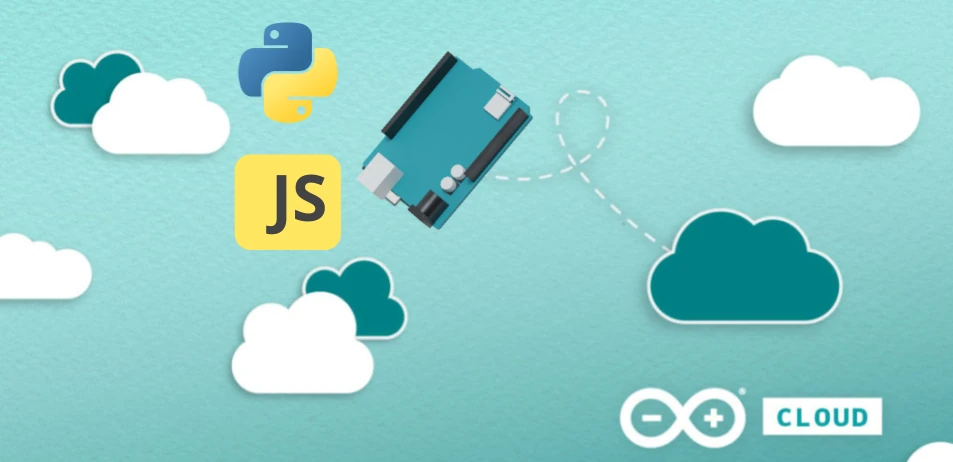The Internet of Things (IoT) has witnessed a remarkable evolution, encompassing diverse applications spanning from small-scale embedded systems to complex networked devices. While traditional IoT development has been synonymous with languages like C and C++, the landscape is rapidly shifting. Modern languages such as Python and JavaScript have gained significant traction in the IoT space, particularly for devices running Linux or other operating systems. Additionally, MicroPython has emerged as a go-to choice for resource-constrained devices.

Excitingly, a groundbreaking development is taking place as Arduino Cloud introduces a revolutionary workflow that seamlessly connects devices programmed in Python, MicroPython, and JavaScript to unlock their full potential in IoT solutions.
Introducing the New Manual Setup Workflow
Until now, Arduino Cloud primarily facilitated the creation of devices based on Arduino or ESP32/ESP8266 hardware, with automatic sketch generation in C/C++ using the Arduino IoT Cloud library. This workflow offered automatic board provisioning and configuration within the platform. However, a new era dawns with the expansion of the device creation process to accommodate Python, MicroPython, and JavaScript applications. This new workflow, aptly named “Manual Setup for Any Device,” equips users with credentials that can be leveraged within their preferred programming environment. Integration with Arduino Cloud becomes possible using libraries developed in any of the supported languages. Users are supported throughout the implementation process with comprehensive documentation and a rich array of examples.
Embracing Diversity
Recognizing the diverse requirements and preferences of developers, Arduino Cloud now offers a flexible workflow. Whether one favors the convenience of automatic provisioning or the flexibility of manual configuration, the choice lies in the hands of the user.
Unlocking the Potential: Python’s Versatility in IoT Development
Python stands as a versatile and widely-used programming language that brings significant advantages to IoT device development. Its simplicity, readability, and extensive library ecosystem make it an ideal choice for developers of all levels of expertise. Python’s vast library ecosystem provides access to pre-built modules and functions, accelerating development through code reuse. Moreover, the active and supportive Python community offers abundant knowledge and resources, making troubleshooting, seeking advice, and learning from others’ experiences easier than ever before.
Python’s Value in AI Programming

Python has also emerged as the de facto standard language and environment for AI programming. With its extensive library ecosystem, featuring popular frameworks like TensorFlow, PyTorch, and scikit-learn, Python is the language of choice for implementing machine learning and deep learning algorithms. Its intuitive syntax and flexibility empower developers to build and deploy sophisticated AI models seamlessly into IoT applications. Python’s dominance in the AI landscape further enhances its value in IoT device development, allowing developers to leverage AI capabilities and unlock advanced functionalities within their IoT solutions.
MicroPython: Power Packed for Tiny Processors
MicroPython has gained immense popularity as a platform for IoT development, offering simplicity, efficiency, and versatility. Supporting various microcontroller platforms, including Arduino, ESP32, and Raspberry Pi Pico, MicroPython ensures cross-platform compatibility. With its familiar Python syntax, MicroPython facilitates easy learning and rapid prototyping. It optimizes memory usage and runtime performance, even on resource-constrained devices. The extensive library ecosystem surrounding MicroPython enables quick integration of functionalities and seamless interoperability with other IoT platforms. Backed by an active community, MicroPython fosters abundant resources, support, and a vibrant ecosystem for IoT innovation.
JavaScript: Empowering Event-Driven Applications
JavaScript has found its place in IoT device development across multiple platforms. Node.js, a server-side runtime environment, harnesses JavaScript’s event-driven and non-blocking nature, enabling efficient handling of IoT tasks. Espruino, a JavaScript platform for microcontrollers, facilitates direct coding on resource-constrained devices. Johnny-Five, a JavaScript robotics and IoT framework, empowers control and interaction with hardware platforms using JavaScript. JavaScript’s versatility, utilization of web development skills, and extensive library support make it an accessible choice for IoT development. Its event-driven nature aligns well with IoT requirements, while frameworks and community support foster rapid development and integration with web-based services.
Arduino Cloud: Simplifying IoT Development
Arduino Cloud emerges as a platform that simplifies the process of developing, deploying, and managing IoT devices. Supporting various hardware options, including Arduino boards, ESP32, and ESP8266 based boards, Arduino Cloud enables makers, IoT enthusiasts, and professionals to build connected projects without extensive coding expertise. What sets Arduino Cloud apart is its intuitive interface that abstracts complex tasks, making it accessible to all users. The low-code approach, complemented by an extensive collection of examples and templates, allows users to focus on their application code while Arduino Cloud handles the rest.
Monitoring and Management Made Easy
The IoT Cloud tool within Arduino Cloud offers effortless management and monitoring of connected devices through customizable dashboards, providing real-time visualizations of device data. Additionally, the mobile app Arduino IoT Cloud Remote allows remote access to the IoT Cloud, enabling users to manage their devices from anywhere using Android and iOS devices.
Embark on Your IoT Journey
Visit the Arduino Cloud website to access official documentation and resources for the Arduino IoT Cloud, where you will find extensive documentation to help you get started with the new Manual device setup workflow. Create an account today and begin building your own IoT projects.
Embracing Innovation and Collaboration
As the IoT landscape continues to evolve, Arduino Cloud remains at the forefront, embracing the flexibility and power of Python and JavaScript. We invite you to explore this exciting new feature, unlock your creativity, and share your innovative projects with the Arduino community. Publish your projects on the Arduino Project Hub (PH), where like-minded enthusiasts can discover, learn, and collaborate on IoT solutions that push the boundaries of possibility.
Engage in community discussions and project sharing on the Arduino forum, providing a platform for exchanging ideas, seeking advice, and fostering collaboration among fellow IoT enthusiasts. Together, let us shape the future of IoT, creating a vibrant ecosystem of innovation and knowledge-sharing.


